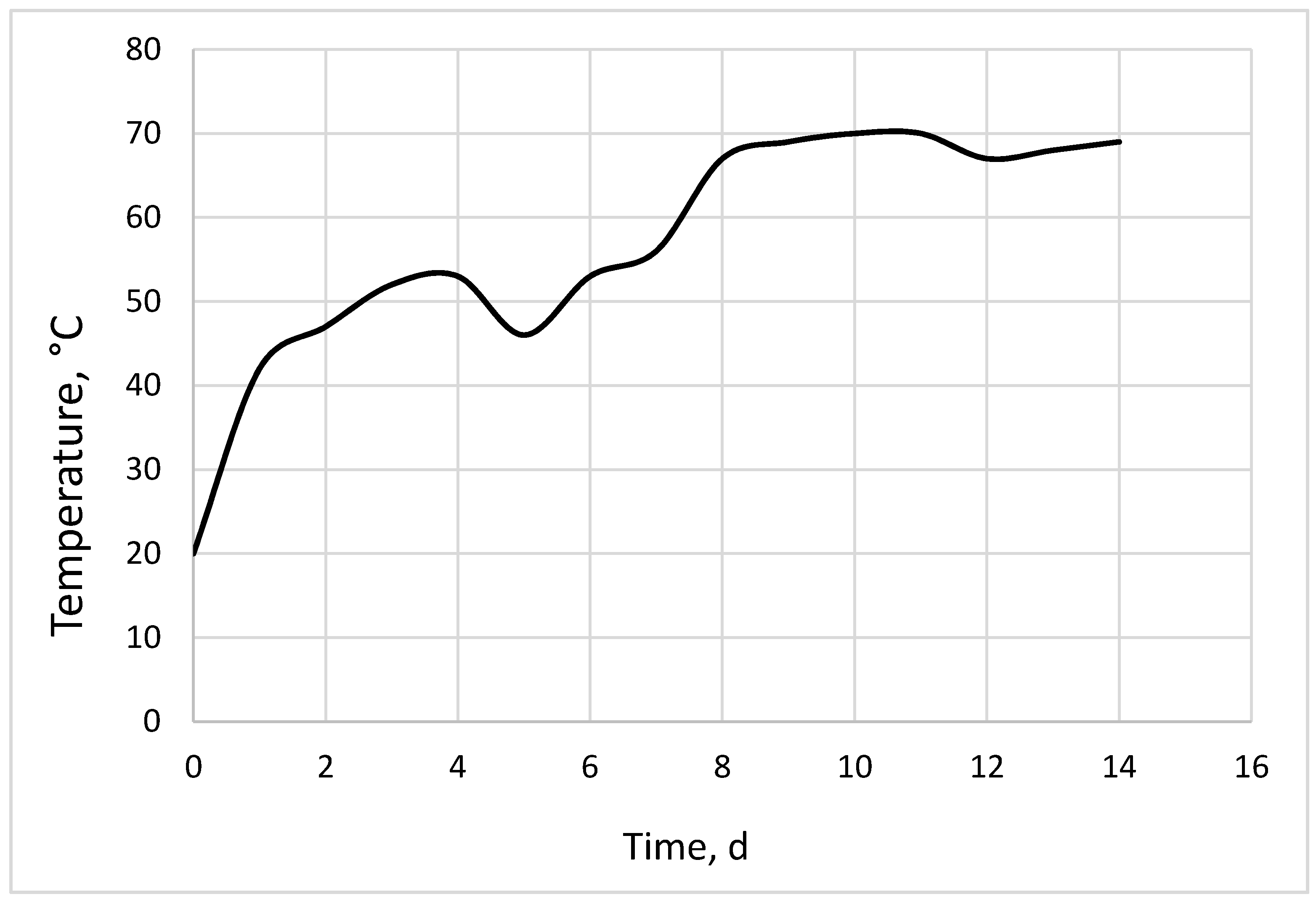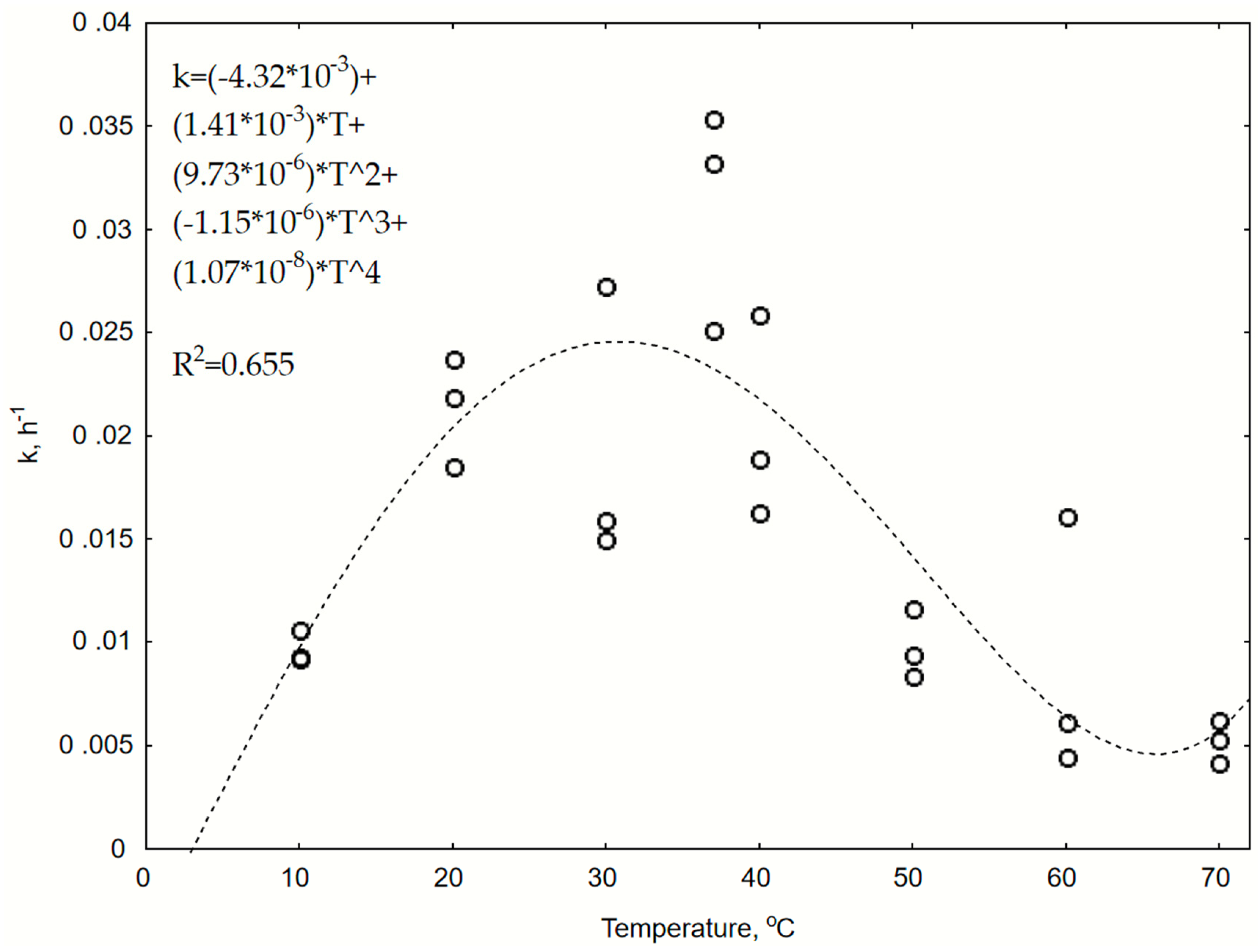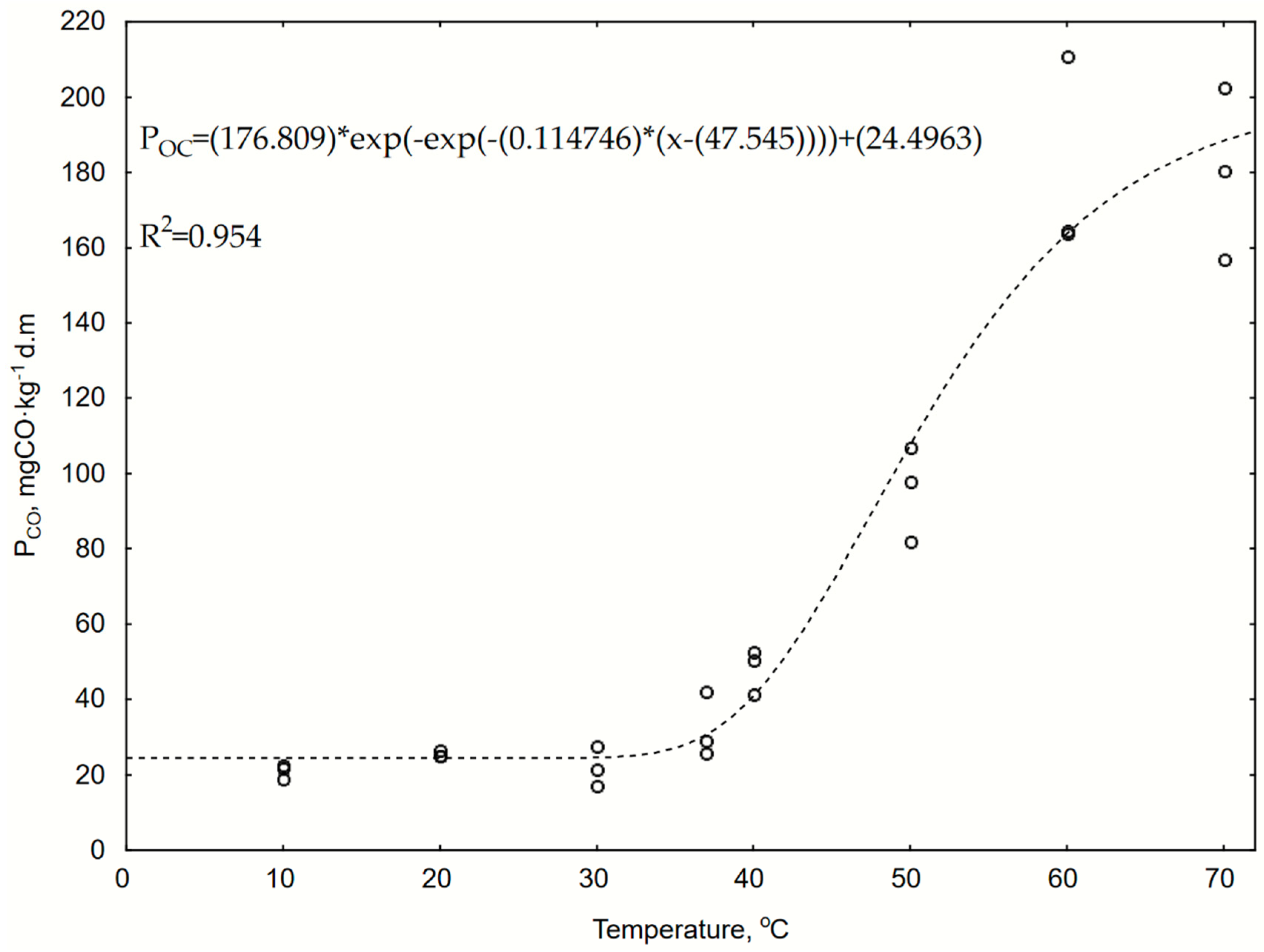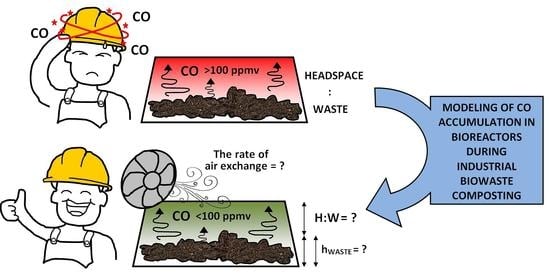Modeling of CO Accumulation in the Headspace of the Bioreactor during Organic Waste Composting
Abstract
:1. Introduction
2. Materials and Methods
2.1. Experimental Setup
2.2. Model of CO Accumulation: Inputs
- the duration of the composting, d
- bulk density of the organic waste, kg∙m−3
- the volume of the bioreactor, m3
- the volume of organic waste in the bioreactor, m3
- the volume of the headspace (above the organic waste), m3
- organic waste dry matter in reactor, kg
- CO concentration threshold value defined as a maximum desired CO level inside the bioreactor headspace for potential short-term occupational exposure, ppm
- the daily mean organic waste temperature during composting, °C.
2.2.1. Waste Characteristics
2.2.2. Composting Method
- (a)
- no ventilation of bioreactor headspace through the entire process (with vigorous ventilation at the end of the process by opening the bioreactor before removal of stabilized product—the compost);
- (b)
- with ventilation defined as a short, daily opening of the bioreactor to release accumulated CO and lower the concentration of CO in the headspace to the atmospheric level, followed by a bioreactor’s closure.
- (c)
- seven ratios of headspace-to-waste volume (H:W) in the reactor (4:1, 3:1, 2:1, 1:1, 1:2, 1:3, 1:4, and H:W, respectively) were considered for modeling of CO accumulation.
2.2.3. CO Inputs
2.3. Analytical Procedures
- PCO—cumulative CO production, µg·g−1d.m., at the given time, t
- PCO0—maximum CO production, µg·g−1d.m.
- k—CO production constant rate, h−1
- t—time, h.
- y—k
- x—T
- a1—intercept,
- a2–a5—regression coefficients.
- T—composting process temperature, °C
- T—composting process temperature on a particular day (from Day 1 to 14, °C).
- MCO—the mass of CO emitted from organic waste during a day, mg∙d−1,
- mdm—organic waste, dry mass, kg.
3. Results
3.1. CO Accumulation in the Headspace of the Bioreactor Without Ventilation
3.2. CO Concentration in the Bioreactor Headspace with the Daily Release of Accumulated Gas
3.3. Air Exchange Rate to Mitigate CO Accumulation
3.4. The Height of the Waste Pile to Minimize the Risk of CO Accumulation
4. Discussion
5. Conclusions and Process Recommendation
Supplementary Materials
Author Contributions
Funding
Institutional Review Board Statement
Informed Consent Statement
Data Availability Statement
Acknowledgments
Conflicts of Interest
References
- Wéry, N. Bioaerosols from composting facilities—A review. Front. Cell. Infect. Microbiol. 2014, 4, 42. [Google Scholar]
- Robertson, S.; Douglas, P.; Jarvis, D.; Marczylo, E. Bioaerosol exposure from composting facilities and health outcomes in workers and in the community: A systematic review update. Int. J. Hyg. Environ. Health 2019, 222, 364–386. [Google Scholar] [CrossRef] [PubMed]
- Pinasseau, A.; Zerger, B.; Roth, J.; Canova, M.; Roudier, S. Best Available Techniques (BAT) Reference Document for Waste Treatment Industrial Emissions Directive 2010/75/EU (Integrated Pollution Prevention and Control); European Commission: Luxemburg, 2018. [Google Scholar]
- Albrecht, A.; Fischer, G.; Brunnemann-Stubbe, G.; Jäckel, U.; Kämpfer, P. Recommendations for study design and sampling strategies for airborne microorganisms, MVOC and odours in the surrounding of composting facilities. Int. J. Hyg. Environ. Health 2008, 211, 121–131. [Google Scholar] [CrossRef] [PubMed]
- Tolvanen, O.; Nykänen, J.; Nivukoski, U.; Himanen, M.; Veijanen, A.; Hänninen, K. Occupational hygiene in a Finnish drum composting plant. Waste Manag. 2005, 25, 427–433. [Google Scholar] [CrossRef]
- Tolvanen, O.K.; Hänninen, K.I. Mechanical-biological waste treatment and the associated occupational hygiene in Finland. Waste Manag. 2006, 26, 1119–1125. [Google Scholar] [CrossRef] [PubMed]
- Nadal, M.; Inza, I.; Schuhmacher, M.; Figueras, M.J.; Domingo, J.L. Health risks of the occupational exposure to microbiological and chemical pollutants in a municipal waste organic fraction treatment plant. Int. J. Hyg. Environ. Health 2009, 212, 661–669. [Google Scholar] [CrossRef] [PubMed]
- Harrison, E.Z. Health impacts of composting air emissions. BioCycle 2007, 48, 44–46+48+50. [Google Scholar]
- Kummer, V.; Thiel, W.R. Bioaerosols–Sources and control measures. Int. J. Hyg. Environ. Health 2008, 211, 299–307. [Google Scholar] [CrossRef]
- Sánchez-Monedero, M.A.; Stentiford, E.I. Generation and Dispersion of Airborne Microorganisms from Composting Facilities. Process Saf. Environ. Prot. 2003, 81, 166–170. [Google Scholar] [CrossRef]
- Taha, M.; Drew, G.; Longhurst, P.; Smith, R.; Pollard, S. Bioaerosol releases from compost facilities: Evaluating passive and active source terms at a green waste facility for improved risk assessments. Atmos. Environ. 2006, 40, 1159–1169. [Google Scholar] [CrossRef]
- Sykes, P.; Morris, R.H.K.; Allen, J.A.; Wildsmith, J.D.; Jones, K.P. Workers’ exposure to dust, endotoxin and β-(1-3) glucan at four large-scale composting facilities. Waste Manag. 2011, 31, 423–430. [Google Scholar] [CrossRef]
- Koskela, R.-S.; Mutanen, P.; Sorsa, J.; Klockars, M. Factors predictive of ischemic heart disease mortality in foundry workers exposed to carbon monoxide. Am. J. Epidemiol. 2000, 152, 628–632. [Google Scholar] [CrossRef] [Green Version]
- Haarstad, K.; Bergersen, O.; Sorheim, R. Occurrence of carbon monoxide during organic waste degradation. J. Air Waste Manag. Assoc. 2006, 56, 575–581. [Google Scholar] [CrossRef] [Green Version]
- Hellebrand, H.J. Emission of Nitrous Oxide and other Trace Gases during Composting of Grass and Green Waste. J. Agric. Eng. Res. 1998, 69, 365–375. [Google Scholar] [CrossRef] [Green Version]
- Hellebrand, H.J.; Kalk, W.-D. Emission of carbon monoxide during composting of dung and green waste. Nutr. Cycl. Agroecosystems 2001, 60, 79–82. [Google Scholar] [CrossRef]
- Stegenta, S.; Sobieraj, K.; Pilarski, G.; Koziel, J.A.; Białowiec, A. Analysis of the Spatial and Temporal Distribution of Process Gases within Municipal Biowaste Compost. Sustainability 2019, 11, 2340. [Google Scholar] [CrossRef] [Green Version]
- Stegenta, S.; Sobieraj, K.; Pilarski, G.; Koziel, J.A.; Białowiec, A. The Spatial and Temporal Distribution of Process Gases within the Biowaste Compost. Data 2019, 4, 37. [Google Scholar] [CrossRef] [Green Version]
- Topacoglu, H.; Katsakoglou, S.; Ipekci, A. Effect of exhaust emissions on carbon monoxide levels in employees working at indoor car wash facilities. Hippokratia 2014, 18, 37–39. [Google Scholar] [PubMed]
- Webster, J. Design of Pulse Oximeters; CRC Press: Boca Raton, FL, USA, 1997. [Google Scholar]
- Forsyth, J.B.; Martin, T.L.; Young-Corbett, D.; Dorsa, E. Feasibility of Intelligent Monitoring of Construction Workers for Carbon Monoxide Poisoning. IEEE Trans. Autom. Sci. Eng. 2012, 9, 505–515. [Google Scholar] [CrossRef]
- Nelson, L.; Hoffman, R. Carbon monoxide. In Rosen’s Emergency Medicine: Concepts and Clinical Practice; MOSBY Elsevier: Philadelphia, PA, USA, 2010; pp. 2037–2038. [Google Scholar]
- Van Meter, K.W.; Weiss, L.; Harch, P.G.; Andrews, L.C.; Simanonok, J.P.; Staab, P.K.; Gottlieb, S.F. Should the pressure be off or on in the use of oxygen in the treatment of carbon monoxide-poisoned patients? Ann. Emerg. Med. 1994, 24, 283–288. [Google Scholar] [CrossRef]
- Koskela, R.S. Cardiovascular diseases among foundry workers exposed to carbon monoxide. Scand. J. Work. Environ. Health 1994, 20, 286–293. [Google Scholar] [CrossRef] [Green Version]
- CDC-NIOSH Pocket Guide to Chemical Hazards-Carbon Monoxide. Available online: https://www.cdc.gov/niosh/npg/npgd0105.html (accessed on 28 December 2020).
- Ernst, A.; Zibrak, J.D. Carbon monoxide poisoning. N. Engl. J. Med. 1998, 339, 1603–1608. [Google Scholar] [CrossRef] [PubMed] [Green Version]
- Stegenta-Dąbrowska, S.; Drabczyński, G.; Sobieraj, K.; Koziel, J.A.; Białowiec, A. The Biotic and Abiotic Carbon Monoxide Formation During Aerobic Co-digestion of Dairy Cattle Manure With Green Waste and Sawdust. Front. Bioeng. Biotechnol. 2019, 7, 283. [Google Scholar] [CrossRef] [PubMed]
- Finstein, M.S.; Miller, F.C.; Strom, P.F.; MacGregor, S.T.; Psarianos, K.M. Composting Ecosystem Management for Waste Treatment. Bio/Technology 1983, 1, 347–353. [Google Scholar] [CrossRef]
- Stegenta-Dąbrowska, S.; Sobieraj, K.; Koziel, J.A.; Bieniek, J.; Białowiec, A. Kinetics of Biotic and Abiotic CO Production during the Initial Phase of Biowaste Composting. Energies 2020, 13, 5451. [Google Scholar] [CrossRef]
- Hemidat, S.; Saidan, M.; Abdallah, N.; Nelles, M. Study and Assessment of Segregated Bio-Waste Composting; Deutschen Gesellschaft für Abfallwirtschaft e.V. (DGAW): Innsbruck, Austria, 2019; pp. 171–177. ISBN 978-3-903187-48-1. [Google Scholar]
- Pikoń, K.; Rejman, R. Bilans pierwiastka węgla w systemie gospodarki odpadami komunalnymi. Arch. Gospod. Odpad. Ochr. Śr. 2009, 11, 27–46. [Google Scholar]
- Ryckeboer, J.; Mergaert, J.; Coosemans, J.; Deprins, K.; Swings, J. Microbiological aspects of biowaste during composting in a monitored compost bin. J. Appl. Microbiol. 2003, 94, 127–137. [Google Scholar] [CrossRef] [PubMed] [Green Version]
- Michel, F.C.; Pecchia, J.A.; Rigot, J.; Keener, H.M. Mass and nutrient losses during the composting of dairy manure amended with sawdust or straw. Compost Sci. Util. 2004, 12, 323–334. [Google Scholar] [CrossRef]
- Stegenta, S.; Dębowski, M.; Bukowski, P.; Randerson, P.F.; Białowiec, A. The influence of perforation of foil reactors on greenhouse gas emission rates during aerobic biostabilization of the undersize fraction of municipal wastes. J. Environ. Manage. 2018, 207, 355–365. [Google Scholar] [CrossRef]
- Haug, R. The Practical Handbook of Compost Engineering; Routledge: Abington, PA, USA, 1993; ISBN 978-1-351-40951-3. [Google Scholar]
- Mason, I.G.; Milke, M.W. Physical modelling of the composting environment: A review. Part 1: Reactor systems. Waste Manag. 2005, 25, 481–500. [Google Scholar] [CrossRef] [PubMed]
- HotRot Composting Systems. Available online: https://www.globalcomposting.solutions/hotrot-technology (accessed on 28 February 2021).
- World Health Organization. Air Quality Guidelines for Europe, 2nd ed.; WHO Regional Publications: Copenhagen, Denmark, 2000; ISBN 92 890 1358 3. [Google Scholar]
- Noori, R.; Hoshyaripour, G.; Ashrafi, K.; Araabi, B.N. Uncertainty analysis of developed ANN and ANFIS models in prediction of carbon monoxide daily concentration. Atmos. Environ. 2010, 44, 476–482. [Google Scholar] [CrossRef]
- Cordero, P.R.F.; Bayly, K.; Leung, P.M.; Huang, C.; Islam, Z.F.; Schittenhelm, R.B.; King, G.M.; Greening, C. Atmospheric carbon monoxide oxidation is a widespread mechanism supporting microbial survival. ISME J. 2019, 13, 2868–2881. [Google Scholar] [CrossRef] [PubMed] [Green Version]
- World Health Organization. Who Guidelines for Indoor Air Quality: Selected Pollutants; World Health Organization, Ed.; WHO: Copenhagen, Denmark, 2010; ISBN 978-92-890-0213-4. [Google Scholar]
- Al-Sultan, A.A.; Jumaah, G.F.; Al-Ani, F.H. Evaluation of the Dispersion of Nitrogen Dioxide and Carbon Monoxide in the Indoor Café–Case Study. J. Ecol. Eng. 2019, 20, 256–261. [Google Scholar] [CrossRef]
- The National Institute for Occupational Safety and Health Carbon Monoxide. Available online: https://www.cdc.gov/index.htm (accessed on 31 March 2020).
- US EPA, O. Carbon Monoxide’s Impact on Indoor Air Quality. Available online: https://www.epa.gov/indoor-air-quality-iaq/carbon-monoxides-impact-indoor-air-quality (accessed on 31 March 2020).
- European Comission. Air Quality Standards; European Comission: Luxemburg, 2010. [Google Scholar]
- Bergmann, M.; Egert, M.; Plenio, H. Malodorogenic Sensing of Carbon Monoxide. Chem. Eur. J. 2017, 23, 13328–13331. [Google Scholar] [CrossRef]
- Carbon Monoxide Concentrations: Table (AEN-172) Department of Agricultural and Biosystems Engineering Iowa State University. Available online: https://www.abe.iastate.edu/extension-and-outreach/carbon-monoxide-concentrations-table-aen-172/ (accessed on 28 December 2020).
- Mohammed, M.N.; Ghanesen, Y.; Al-Zubaidi, S.; Ali, M.A.M.; Al-Sanjary, O.I.; Zamani, N.S. Investigation on Carbon Monoxide Monitoring and Alert System for Vehicles. In Proceedings of the 2019 IEEE 15th International Colloquium on Signal Processing Its Applications (CSPA), Penang, Malaysia, 8–9 March 2019; pp. 239–242. [Google Scholar]
- Kilian, E.; Macedowska-Capiga, A. Parametr AT4 jako wskaźnik stopnia stabilizacji odpadów po mechaniczno-biologicznym przetworzeniu. Pr. Inst. Ceram. Mater. Bud. 2011, 4, 88–94. [Google Scholar]
- Stegenta, S.; Kałdun, B.; Białowiec, A. Dobór modelu i wyznaczanie parametrów kinetycznych aktywności oddechowej odpadów w trakcie procesu tlenowej biostabilizacji frakcji podsitowej odpadów komunalnych. Rocz. Ochr. Śr. 2016, 18, 800–814. [Google Scholar]
- Hanusz, Z.; Siarkowski, Z.; Ostrowski, K. Application of the Gompertz model in agricultural engineering. Agric. Eng. 2008, 7, 71–77. [Google Scholar]
- Yang, X.; Zhu, W.; Koziel, J.A.; Cai, L.; Jenks, W.S.; Laor, Y.; van Leeuwen, J.H.; Hoff, S.J. Improved quantification of livestock associated odorous volatile organic compounds in a standard flow-through system using solid-phase microextraction and gas chromatography–mass spectrometry. J. Chromatogr. A 2015, 1414, 31–40. [Google Scholar] [CrossRef] [Green Version]
- Gao, M.; Liang, F.; Yu, A.; Li, B.; Yang, L. Evaluation of stability and maturity during forced-aeration composting of chicken manure and sawdust at different C/N ratios. Chemosphere 2010, 78, 614–619. [Google Scholar] [CrossRef]
- Keener, H.M.; Marugg, C.; Hansen, R.C.; Hoitink, H.A.J. Optimizing the efficiency of the composting process. In Science and Engineering of Composting: Design, Environ- Mental, Microbiological and Utilization Aspects; Renaissance Publications: Worthington, MN, USA, 1993. [Google Scholar]
- Finstein, M.S.; Miller, F.C. Waste treatment composting as a controlled system. In Biotechnology (Biodegradations); WCH Verlagsgesellschaft: Weinheim, Germany, 1986; Volume 8, pp. 363–398. [Google Scholar]
- Lokin, P.; Oorthuys, T. Major Benefits from Tunnel Composting for Production of Biowaste Compost and Dried Sludge. In European Conference on Sludge and Organic Waste; University of Leeds: Leeds, UK, 1994. [Google Scholar]
- Seki, H. New Deterministic Model for Forced-Aeration Composting Processes with Batch Operation. Trans. ASAE 2002, 45, 1239. [Google Scholar] [CrossRef]
- Rasapoor, M.; Nasrabadi, T.; Kamali, M.; Hoveidi, H. The effects of aeration rate on generated compost quality, using aerated static pile method. Waste Manag. 2009, 29, 570–573. [Google Scholar] [CrossRef]
- Bari, Q.H.; Koenig, A. Application of a simplified mathematical model to estimate the effect of forced aeration on composting in a closed system. Waste Manag. 2012, 32, 2037–2045. [Google Scholar] [CrossRef]
- Chen, Z.; Zhang, S.; Wen, Q.; Zheng, J. Effect of aeration rate on composting of penicillin mycelial dreg. J. Environ. Sci. 2015, 37, 172–178. [Google Scholar] [CrossRef]
- Guo, R.; Li, G.; Jiang, T.; Schuchardt, F.; Chen, T.; Zhao, Y.; Shen, Y. Effect of aeration rate, C/N ratio and moisture content on the stability and maturity of compost. Bioresour. Technol. 2012, 112, 171–178. [Google Scholar] [CrossRef]
- Pos, J. Composting––Theoretical Applications, Municipal and Commercial Composting Workshop; University of Guelph: Guelph, ON, Canada, 1991. [Google Scholar]
- Petric, I.; Selimbašić, V. Development and validation of mathematical model for aerobic composting process. Chem. Eng. J. 2008, 139, 304–317. [Google Scholar] [CrossRef]
- Petric, I.; Mustafić, N. Dynamic modeling the composting process of the mixture of poultry manure and wheat straw. J. Environ. Manage. 2015, 161, 392–401. [Google Scholar] [CrossRef] [PubMed]
- Nada, W.M. Stability and maturity of maize stalks compost as affected by aeration rate, C/N ratio and moisture content. J. Soil Sci. Plant Nutr. 2015, 15, 751–764. [Google Scholar] [CrossRef]
- Bueno, P.; Tapias, R.; López, F.; Díaz, M.J. Optimizing composting parameters for nitrogen conservation in composting. Bioresour. Technol. 2008, 99, 5069–5077. [Google Scholar] [CrossRef] [PubMed]
- Keener, H.M.; Elwell, D.L.; Ekinci, K.; Hoitink, H.A.J. Composting and Value-Added Utilization of Manure From a Swine Finishing Facility. Compost Sci. Util. 2001, 9, 312–321. [Google Scholar] [CrossRef]
- Kulcu, R.; Yaldiz, O. Determination of aeration rate and kinetics of composting some agricultural wastes. Bioresour. Technol. 2004, 93, 49–57. [Google Scholar] [CrossRef] [PubMed]
- Yuan, J.; Chadwick, D.; Zhang, D.; Li, G.; Chen, S.; Luo, W.; Du, L.; He, S.; Peng, S. Effects of aeration rate on maturity and gaseous emissions during sewage sludge composting. Waste Manag. 2016, 56, 403–410. [Google Scholar] [CrossRef] [PubMed]
- Keener, H.M.; Elwell, D.L.; Das, K.; Hansen, R.C. Specifying design/operation of composting systems using pilot scale data. Appl. Eng. Agric. 1997, 13, 767–772. [Google Scholar] [CrossRef]
- Rynk, R.; van de Kamp, M.; Willson, G.B.; Singley, M.E.; Richard, T.L.; Kolega, J.J.; Gouin, F.R.; Laliberty, L.; Kay, D.; Murphy, D.; et al. On-Farm Composting Handbook (NRAES 54); Northeast Regional Agricultural Engineering Service (NRAES): New York, NY, USA, 1992. [Google Scholar]
- Mohee, R.; White, R.K.; Das, K.C. Simulation Model for Composting Cellulosic (Bagasse) Substrates. Compost Sci. Util. 1998, 6, 82–92. [Google Scholar] [CrossRef] [Green Version]
- Yamada, Y.; Kawase, Y. Aerobic composting of waste activated sludge: Kinetic analysis for microbiological reaction and oxygen consumption. Waste Manag. 2006, 26, 49–61. [Google Scholar] [CrossRef] [PubMed]
- Jędrczak, A.; den Boer, E. Raport Końcowy III Etapu Ekspertyzy Mającej na Celu Przeprowadzenie Badań Odpadów w 20 Instalacjach do Mechaniczno-Biologicznego Przetwarzania Odpadów (The final Report of the Third Stage of the Expertise Aimed at to Conduct Waste Tests in 20 Mechanical-Biological Installations Waste Treatment); Uniwersytet Zielonogórski i Zakład Utylizacji Odpadów, Spółka z o.o.: Zielona Góra, Poland, 2015. [Google Scholar]
- Kuter, G.A.; Hoitink, H.A.J.; Rossman, L.A. Effects of Aeration and Temperature on Composting of Municipal Sludge in a Full-Scale Vessel System. J. Water Pollut. Control Fed. 1985, 57, 309–315. [Google Scholar]
- Shen, Y.; Ren, L.; Li, G.; Chen, T.; Guo, R. Influence of aeration on CH4, N2O and NH3 emissions during aerobic composting of a chicken manure and high C/N waste mixture. Waste Manag. 2011, 31, 33–38. [Google Scholar] [CrossRef] [PubMed]
- Lau, A.K.; Liao, P.H.; Lo, K.V. Evaluation of swine waste composting in vertical reactors. J. Environ. Sci. Health Part Environ. Sci. Eng. Toxicol. 1993, 28, 761–777. [Google Scholar] [CrossRef]
- Finstein, M.S.; Miller, F.C. Principles of composting leading to maximization of decomposition rate, odor control, and cost effectiveness. In Composting of Agricultural and Other Wastes; Gasser, J.K.R., Ed.; Elsevier Applied Science Publishers: London, UK, 1985. [Google Scholar]
- The Council of the European Communities. Directive 89/654/EEC-Workplace Requirements-EU-OSHA (OJ L 393, 30.12.1989, p.1); The Council of the European Communities: Luxemburg, 1989. [Google Scholar]
- The Council of the European Communities Council. Directive 89/656/EEC of 30 November 1989 on the Minimum Health and Safety Requirements for the Use by Workers of Personal Protective Equipment at the Workplace; The Council of the European Communities: Luxemburg, 1989. [Google Scholar]
- The Council of the European Communities Council. Directive 92/58/EEC of 24 June 1992 on the Minimum Requirements for the Provision of Safety and/or Health Signs at Work; The Council of the European Communities: Luxemburg, 1992. [Google Scholar]






Publisher’s Note: MDPI stays neutral with regard to jurisdictional claims in published maps and institutional affiliations. |
© 2021 by the authors. Licensee MDPI, Basel, Switzerland. This article is an open access article distributed under the terms and conditions of the Creative Commons Attribution (CC BY) license (http://creativecommons.org/licenses/by/4.0/).
Share and Cite
Sobieraj, K.; Stegenta-Dąbrowska, S.; Koziel, J.A.; Białowiec, A. Modeling of CO Accumulation in the Headspace of the Bioreactor during Organic Waste Composting. Energies 2021, 14, 1367. https://doi.org/10.3390/en14051367
Sobieraj K, Stegenta-Dąbrowska S, Koziel JA, Białowiec A. Modeling of CO Accumulation in the Headspace of the Bioreactor during Organic Waste Composting. Energies. 2021; 14(5):1367. https://doi.org/10.3390/en14051367
Chicago/Turabian StyleSobieraj, Karolina, Sylwia Stegenta-Dąbrowska, Jacek A. Koziel, and Andrzej Białowiec. 2021. "Modeling of CO Accumulation in the Headspace of the Bioreactor during Organic Waste Composting" Energies 14, no. 5: 1367. https://doi.org/10.3390/en14051367









